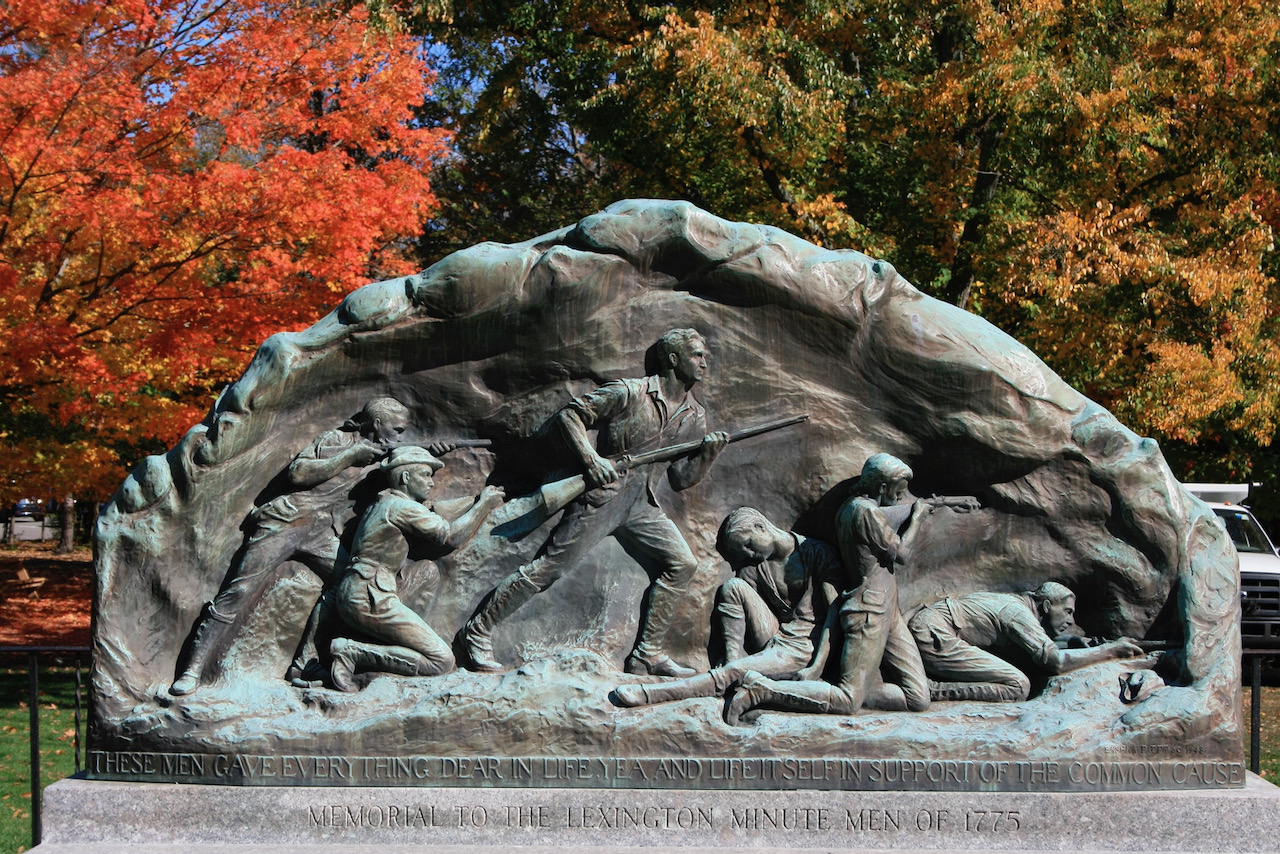The Lexington Minutemen Memorial sits across from Lexington Green near Buckman Tavern. Set on a granite base, it depicts six minutemen posed in various stances as they fight at the Battle of Lexington. Three are shooting, two on their knees, and one stands. One crouches to avoid being shot while another rushes forward. Another slumps, as if dead. A knee-high iron fence surrounds the monument.
The inscription at the base of the monument to the Lexington Minute Men reads:
These men gave everything in life yea and
life itself in support of the common cause.
Erected in 1948, the sculpture was created by Russian-born sculptor Bashka Paeff (1893-1979). Paeff emigrated to the United States as a one-year-old with her family 1894. In her early teens she enrolled in the Boston Normal Art School (now Massachusetts College of Art and Design), completing programs in drawing, painting and art education. There she studied sculpture under Cyrus E. Dallin of Arlington, Massachusetts, graduating in 1911, and continued in 1914 at the School of the Museum of Fine Arts, Boston.
Paeff is known as the “subway sculptor” having supported her work with a job as a toll collector in Boston’s Park Street T station. Most recognized for her controversial Sacrifices of War memorial on the Portsmouth, New Hampshire/Kittery, Maine border, Paeff stated, “I hope most of all that we shall not erect memorials to glorify war… we forget what suffering and horror it brought. We should set up memorials that would make us loathe war instead of admire it.”
Her sculpture honoring Lexington’s minutemen reflects the battle, the bravery and the fragility of life lest we forget how independence was forged.
Memorial
to the Lexington Minute Men who were
on the Green in the early morning engagement
April 19, 1775
Capt. John Parker • Ens. Joseph Simonds • Corp. Joel Viles • Corp. Ebenezer Parker
Lt. William Tidd • Clerk Daniel Habrington • Corp. Samuel Sanderson • Drummer William Diamond
Ens. Robert Munroe • Orderly Sgt. William Munroe • Corp. John Munroe • Fifer Jonathan Harrington
Ebenezer Bowman • John Bridge Jr. • James Brown • John Brown • Solomon Brown • John Chandler • John Chandler Jr. • Joseph Douglass • Isaac Durant • Prince Estabrook • Nathaniel Farmer • Isaac Green • William Grimes • Caleb Harrington • John Harrington • Jonathan Harrington Jr. • Moses Harrington 3rd • Moses Harrington Jr. • Thaddeus Harrington • Thomas Harrington • Isaac Hastings • Samuel Hastings • Samuel Hadley • Thomas Hadley Jr. • John Hosmer • Micah Hagar • Amos Lock • Benjamin Lock • Benezer Lock • Reuben Lock • Abner Mead • Ebenezer Munroe Jr. • Thaddeus Bowman • Jediah Munroe • John Munroe Jr. • William Munroe 3rd • Nathaniel Mulliken • Isaac Muzzy • John Muzzy • Jonas Parker • Jonas Parker Jr. • Nathaniel Parkhurst • Solomon Pierce • Sgt. Francis Brown • Joshua Reed • Joshua Reed Jr. • Nathan Reed • John Robbins • Philip Russell • Benjamin Sampson • Joshua Simonds • John Smith • Phineas Smith • Simeon Snow • Phineas Stearns • Jonas Stone Jr. • John Tidd • Samuel Tidd • Joseph Underwood • Benjamin Wellington • Enoch Wellington • John Winship • Sylbanus Wood • James Wyman • Nathaniel Wyman
No official list was ever issued by the company or by the town. These names are those listed by historian Frank Warren Coburn in his 1912 book, The Battle of April 19, 1775 in Lexington, Concord, Lincoln, Arlington, Cambridge, Somerville, and Charlestown, Massachusetts.
Sources: Historical Marker Database, Waymarking.com, Wikipedia, Jewish Women’s Archive

